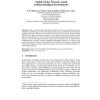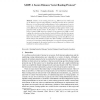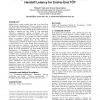315 search results - page 60 / 63 » A framework for adaptive opportunistic forwarding in wireles... |
INFOCOM
2005
IEEE
14 years 1 months ago
2005
IEEE
Abstract— Fluctuations in network conditions are a common phenomenon. They arise in the current wired Internet due to changes in demand, and in wireless networks due to changing ...
JUCS
2006
13 years 7 months ago
2006
: Lately, wireless networks have gained acceptance for home networking. Low cost installation, flexibility and no fixed infrastructures have made it possible home environments rapi...
TON
2010
13 years 2 months ago
2010
We study the contention/interaction among wireless nodes and med -ium access control design in game theory framework. We define a general class of games, called random access game...
ACNS
2004
Springer
14 years 1 months ago
2004
Springer
Distance vector routing protocols (e.g., RIP) have been widely used on the Internet, and are being adapted to emerging wireless ad hoc networks. However, it is well-known that exis...
MOBICOM
2003
ACM
14 years 1 months ago
2003
ACM
Handoff latency results in packet losses and severe End-to-End TCP performance degradation as TCP, perceiving these losses as congestion, causes source throttling or retransmissio...



